Influence of Nanofibrillated Bacterial Cellulose on the Properties of Ordinary and Expansive Mortars
Abstract
:1. Introduction
2. Experimental Outlines
2.1. Materials
2.2. Experimental Plan
2.3. Experimental Method
2.3.1. Fresh Properties
2.3.2. Restraint Expansion Test
2.3.3. Dry Shrinkage Test
2.3.4. Strength Properties
2.3.5. Freeze-Thaw Test
3. Results and Discussion
3.1. Flow and Air Content
3.2. Setting Time
3.3. Expansion Coefficient under Restraint Condition
3.4. Dry Shrinkage
3.5. Compression Strength and Splitting Tensile Strength
3.6. Frost Resistance
4. Conclusions
Author Contributions
Funding
Institutional Review Board Statement
Informed Consent Statement
Data Availability Statement
Acknowledgments
Conflicts of Interest
References
- Hiroshi, U.; Kenji, T.; Ryota, K.; Tatsuhiro, I.; Tokuo, M.; Toru, N. Trends in the Production and Application of Cellulose Nanofibers, 1st ed.; Yuya, H., Takako, K., Eds.; CMC Publishing Co., Ltd.: Tokyo, Japan, 2019. (In Japanese) [Google Scholar]
- David, W.W.; Haiying, W.; Alec, C.G.; Junlong, S.; Yongcan, J.; Huining, X. Superhydrophobic modification of cellulose and cotton textiles: Methodologies and applications. J. Bioresour. Bioprod. 2020, 5, 1–15. [Google Scholar] [CrossRef]
- Hiroyuki, Y. Production of cellulose nanofibers and their applications. Nippon Gomu Kyokaishi 2012, 85, 376–381. (In Japanese) [Google Scholar]
- Robert, J.M.; Ashlie, M.; John, N.; John, S.; Jeff, Y. Cellulose nanomaterials review: Structure, properties and nanocomposites. Chem. Soc. Rev. 2011, 40, 3941–3994. [Google Scholar] [CrossRef]
- Lindong, Z.; Hyun Chan, K.; Jung, W.K.; Jinmo, K.; Jaehwan, K. Elastic moduli of cellulose nanofibers isolated from various cellulose resources by using aqueous counter collision. Cellulose 2018, 25, 4261–4268. [Google Scholar] [CrossRef]
- István, S.; David, P. Microfibrillated cellulose and new nanocomposite materials: A review. Cellulose 2010, 17, 459–494. [Google Scholar] [CrossRef]
- Hiroyuki, Y.; Akira, H.; Kazuo, K. Forefront of Cellulose Nanofiber Research and Practical Use, 1st ed.; NTS: Tokyo, Japan, 2021; pp. 3–95. (In Japanese) [Google Scholar]
- Hiroyuki, K.; Taiki, U.; Haruto, T.; Tokuo, M.; Kenji, T. Nanofibrillated bacterial cellulose modified with (3-Aminopropyl) trimethoxysilane under aqueous conditions: Applications to poly (methyl methacrylate) fiber-reinforced nanocomposites. ACS Omega 2020, 5, 29561–29569. [Google Scholar] [CrossRef]
- Ryota, K.; Naoki, S.; Makoto, Y.; Kenji, T. One-step production of nanofibrillated bacterial cellulose (NFBC) from waste glycerol using Gluconacetobacter intermedius NEDO-01. Cellulose 2013, 20, 2971–2979. [Google Scholar] [CrossRef]
- Obinna, O.; Daman, K.P.; Mohini, S. Properties of nanofibre reinforced cement composites. Constr. Build. Mater. 2014, 63, 119–124. [Google Scholar] [CrossRef]
- Hmet, C.; Murat, K.; Nursel, P.B. Flexural stress enhancement of concrete by incorporation of algal cellulose nanofibers. Constr. Build. Mater. 2017, 149, 289–295. [Google Scholar] [CrossRef]
- Roukaya, M.; Halim, H.; Joan, J.S.; Mohamed, K.; Adel, M.; Sami, B. Nanofibrillated cellulose as nanoreinforcement in Portland cement: Thermal, mechanical and microstructural properties. J. Compos. Mater. 2016, 51, 2491–2503. [Google Scholar] [CrossRef]
- Li, J.; Ming, S.; Liao, C.; Yuangang, W.; Hongli, Z.; Hongqi, D. Natural cellulose nanofibers as sustainable enhancers in construction cement. PLoS ONE 2016, 11, e0168422. [Google Scholar] [CrossRef] [Green Version]
- Wataru, S.; Yosuke, O.; Taku, M.; Hideaki, T. Fundamental properties of cellulose nanofiber concrete. In Summaries of Technical Papers of Annual Meeting of Architectural Institute of Japan (Sendai); Architectural Institute of Japan: Tokyo, Japan, 2018; pp. 743–744. (In Japanese) [Google Scholar]
- Jose, G.; Mounir, E.l.-B.; Yaman, B.; Vivek, B. Cellulose nanofibres (CNF) for sulphate resistance in cement based systems. Cem. Concr. Compos. 2019, 99, 100–111. [Google Scholar] [CrossRef]
- Hassan, E.; Laura, R.; Maurizio, B.; Luca, V.; Enrico, G.; Carlo, P.; Gilberto, A. Influence of cellulose nanofibrils on the rheology, microstructure and strength of alkali activated ground granulated blast-furnace slag: A comparison with ordinary Portland cement. Mater. Struct. 2021, 54, 23. [Google Scholar] [CrossRef]
- Mohammed, A.A. Effect of CNF on Drying Shrinkage and Autogenous Shrinkage of Cement Paste. Doctoral Thesis, University of Maine, Orono, ME, USA, 2017; p. 2794. [Google Scholar]
- Zhidong, Z.; George, W.S. Measuring chemical shrinkage of ordinary Portland cement pastes with high water-to-cement ratios by adding cellulose nanofibrils. Cem. Concr. Compos. 2020, 111, 103625. [Google Scholar] [CrossRef]
- Ana, B.; Elena, F.; Angeles, B.; Carlos, N. Nanocelluloses: Natural-based materials for fiber-reinforced cement composites. A critical review. Polymers 2019, 11, 518. [Google Scholar] [CrossRef] [Green Version]
- Ramnath, N.S. RILEM symposium 1975 fibre reinforced cement and concrete. Matériaux Constr. 1976, 9, 375–377. [Google Scholar] [CrossRef]
- Hans, W.R. International workshop—High performance fibre reinforced cement composites. Mater. Struct. 1992, 25, 60–62. [Google Scholar] [CrossRef]
- Andrzej, M.B. Fibre reinforced cement-based composites (FRC) after over 40 years of development in building and civil engineering. Compos. Struct. 2008, 86, 3–9. [Google Scholar] [CrossRef]
- Pei, Y.; Bing, C.; Sher, A.; Muhammad, A.H.; Meng, W.; Jiaxing, H. Experimental research on ductility enhancement of ultra-high performance concrete incorporation with basalt fibre, polypropylene fibre and glass fibre. Constr. Build. Mater. 2021, 279, 122489. [Google Scholar] [CrossRef]
- Muhammad, U.F.; Majid, A. Contribution of plant fibers in improving the behavior and capacity of reinforced concrete for structural applications. Constr. Build. Mater. 2018, 182, 94–107. [Google Scholar] [CrossRef]
- Hector, A.; Sebastian, K.; David, T.; Edwin, Z.E.; Kent, A.H. Bamboo reinforced concrete: A critical review. Mater. Struct. 2018, 51, 102. [Google Scholar] [CrossRef] [Green Version]
- Romildo, D.T.F.; Karen, S.; George, L.E.; Khosrow, G. Durability of alkali-sensitive sisal and coconut fibres in cement mortar composites. Cem. Concr. Compos. 2000, 22, 127–143. [Google Scholar] [CrossRef]
- Ramakrishna, G.; Sundararajan, T. Studies on the durability of natural fibres and the effect of corroded fibres on the strength of mortar. Cem. Concr. Compos. 2005, 27, 575–582. [Google Scholar] [CrossRef]
- Qi, C.; Yinliang, C.; Mingli, C.; Quanqing, G. Workability, strength and shrinkage of fiber reinforced expansive self-consolidating concrete. Constr. Build. Mater. 2017, 131, 178–185. [Google Scholar] [CrossRef]
- Japanese Industrial Standard. JIS R 5201; Physical Testing Methods for Cement. Japanese Standards Association: Tokyo, Japan, 2015. (In Japanese)
- Japanese Industrial Standard. JIS A 1128; Method of Test for Air Content of Fresh Concrete by Pressure Method. Japanese Standards Association: Tokyo, Japan, 2019. (In Japanese)
- Japanese Industrial Standard. JIS A 1147; Method of Test for Time of Setting of Concrete Mixtures by Penetration Resistance. Japanese Standards Association: Tokyo, Japan, 2019. (In Japanese)
- Japan Concrete Institute Standard. JCI-S-009-2012; Method of Test for Restrained Expansion of Expansive Concrete Using a Cylindrical Mold. Japanese Standards Association: Tokyo, Japan, 2012. (In Japanese)
- Japanese Industrial Standard. JIS A 1129-3; Methods of Measurement for Length Change of Mortar and Concrete—Part 3: Method with Dial Gauge. Japanese Standards Association: Tokyo, Japan, 2010. (In Japanese)
- Japanese Industrial Standard. JIS A 1108; Method of Test for Compressive Strength of Concrete. Japanese Standards Association: Tokyo, Japan, 2018. (In Japanese)
- Japanese Industrial Standard. JIS A 1113; Method of Test for Splitting Tensile Strength of Concrete. Japanese Standards Association: Tokyo, Japan, 2018. (In Japanese)
- Japanese Industrial Standard. JIS A 1148; Method of Test for Resistance of Concrete to Freezing and Thawing. Japanese Standards Association: Tokyo, Japan, 2010. (In Japanese)
- Osman, C.; Cenap, O.; Witold, B.; Gonzalo, M.B. Mechanical properties of self-compacting concrete reinforced with polypropylene fibres. Mater. Res. Innov. 2011, 15, 216–225. [Google Scholar] [CrossRef]
- Xuhui, Z.; Wei, Z.; Cuodong, C.; Fu, X.; Caiqian, Y. Positive effects of aligned steel fiber on bond behavior between steel rebar and concrete. Cem. Concr. Compos. 2020, 114, 103828. [Google Scholar] [CrossRef]
- Neville, A.M. Properties of Concrete, 5th ed.; Pitman Publishing: London, UK, 2012; p. 755. [Google Scholar]
- Peter, L.; Erick, R.; Béatrice, H. About the measurement of the air content in mortar. Mater. Struct. 1999, 32, 618–621. [Google Scholar] [CrossRef]
- Architectural Institute of Japan. Recommendation for Mix Design, Production and Construction Practice of Concrete with Expansive Additive and/or Shrinkage Reducing Admixture, 1st ed.; Architectural Institute of Japan: Tokyo, Japan, 2017; pp. 50–74. (In Japanese) [Google Scholar]
- Ole, M.J.; Per, F.H. Water-entrained cement-based materials: II. Experimental observations. Cem. Concr. Res. 2002, 32, 973–978. [Google Scholar] [CrossRef]
- Hammer, T.A.; Fosså, K.T. Influence of entrained air voids on pore water pressure and volume change of concrete before and during setting. Mater. Struct. 2006, 39, 801–808. [Google Scholar] [CrossRef]
- Linghong, Z.; Lionel, J.J.C.; Raymond, J.B.; Andrew, C.L.; Hassan, H.E.; Stephen, D.K. Effects of saccharide set retarders on the hydration of ordinary Portland cement and pure tricalcium silicate. J. Am. Ceram. Soc. 2009, 93, 279–287. [Google Scholar] [CrossRef]
- Akogu, E.A. Effects of sugar on physical properties of ordinary Portland cement paste and concrete. AU J. T. 2011, 14, 225–228. [Google Scholar]
- Abalaka, A.E. Comparative effects of cassava starch and simple sugar in cement mortar and concrete. ATBU J. Environ. Technol. 2011, 4, 13–22. [Google Scholar]
- Hajime, O.; Yukikazu, T.; Katsumi, G. Compressive strength of uniaxially restrained expansive concrete. Proc. Jpn. Concr. Inst. 1979, 1, 85–88. (In Japanese) [Google Scholar]
- Yukikazu, T.; Kyuichi, M. Fundamental study on the influence of restraining method in the mechanical behaviors of expansive concrete. Proc. Jpn. Concr. Inst. 1984, 6, 341–344. (In Japanese) [Google Scholar]
- Nguyen, D.V.; Emika, K.; Jihoon, K.; Hyeonggil, C.; Yukio, H. Influence of restrained condition on mechanical properties, frost resistance, and carbonation resistance of expansive concrete. Materials 2020, 13, 2136. [Google Scholar] [CrossRef]
- Changwen, M.; Ru, M.; Qian, T.; Wei, S. Effect of sulfate solution on the frost resistance of concrete with and without steel fiber reinforcement. Cem. Concr. Res. 2002, 32, 31–34. [Google Scholar] [CrossRef]
- Mustafa, S.; Erdoğan, Ö.; Hasan, E.Y.; Mohamed, L.; Victor, C.L. Frost resistance and microstructure of Engineered Cementitious Composites: Influence of fly ash and micro poly-vinyl-alcohol fiber. Cem. Concr. Compos. 2012, 34, 156–165. [Google Scholar] [CrossRef]
- Jeongsoo, N.; Gyuyong, K.; Bokyeong, L.; Ryo, H.; Yukio, H. Frost resistance of polyvinyl alcohol fiber and polypropylene fiber reinforced cementitious composites under freeze thaw cycling. Compos. Part B 2016, 90, 241–250. [Google Scholar] [CrossRef]
- Lei, W.; Fanxing, G.; Huamei, Y.; Yan, W.; Shengwen, T. Comparison of fly ash, PVA fiber, MgO and shrinkage-reducing admixture on the frost resistance of face slab concrete via pore structural and fractal analysis. Fractals 2021, 29, 2140002. [Google Scholar] [CrossRef]
- Eiji, K.; Yoshiro, K. Applicability of length change as an index of frost resistance. Annu. Rep. Cem. Concr. Eng. 1971, 25, 313–316. (In Japanese) [Google Scholar]
- Takehumi, Y. Change in concrete length due to freeze-thaw action. Annu. Rep. Cem. Concr. Eng. 1976, 30, 299–301. (In Japanese) [Google Scholar]
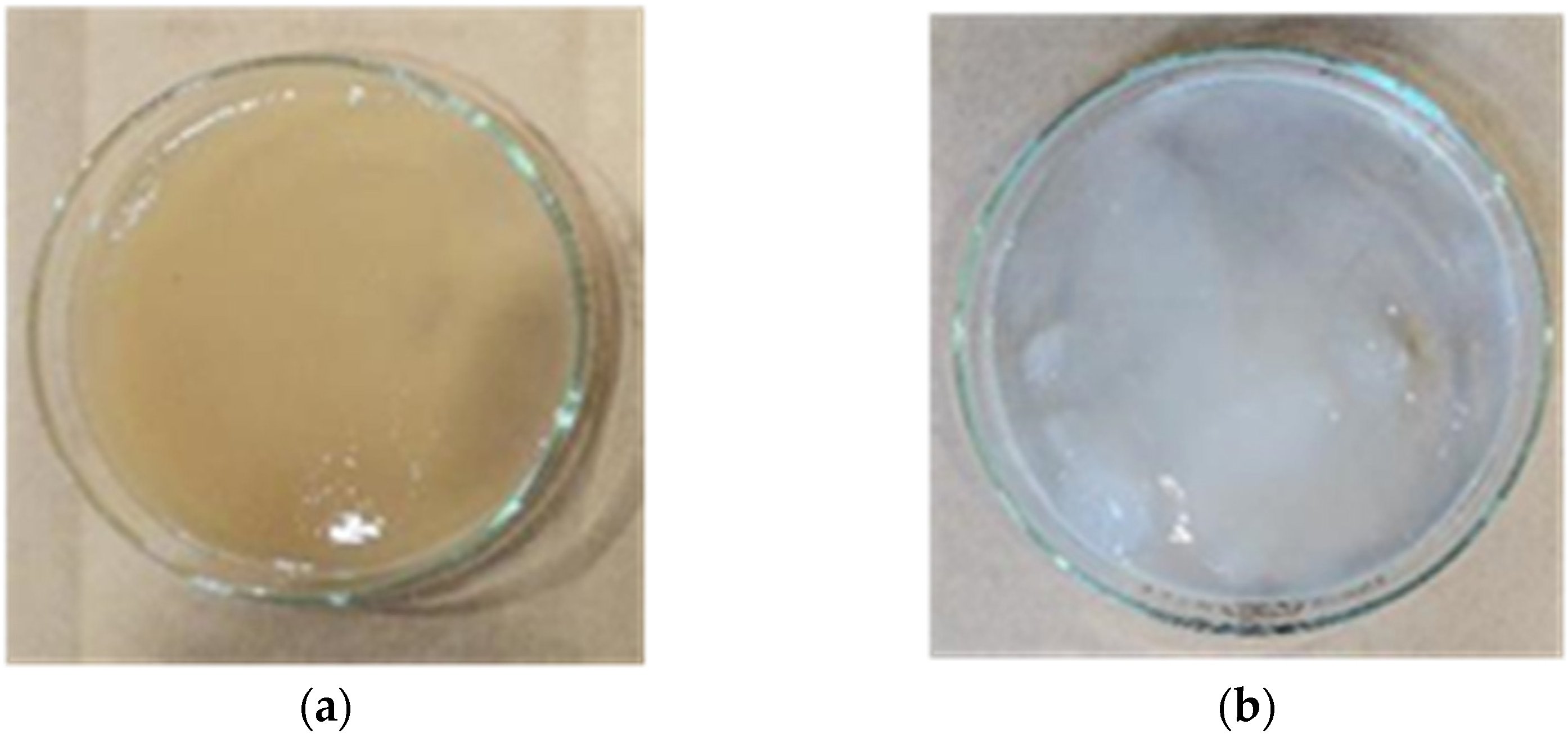
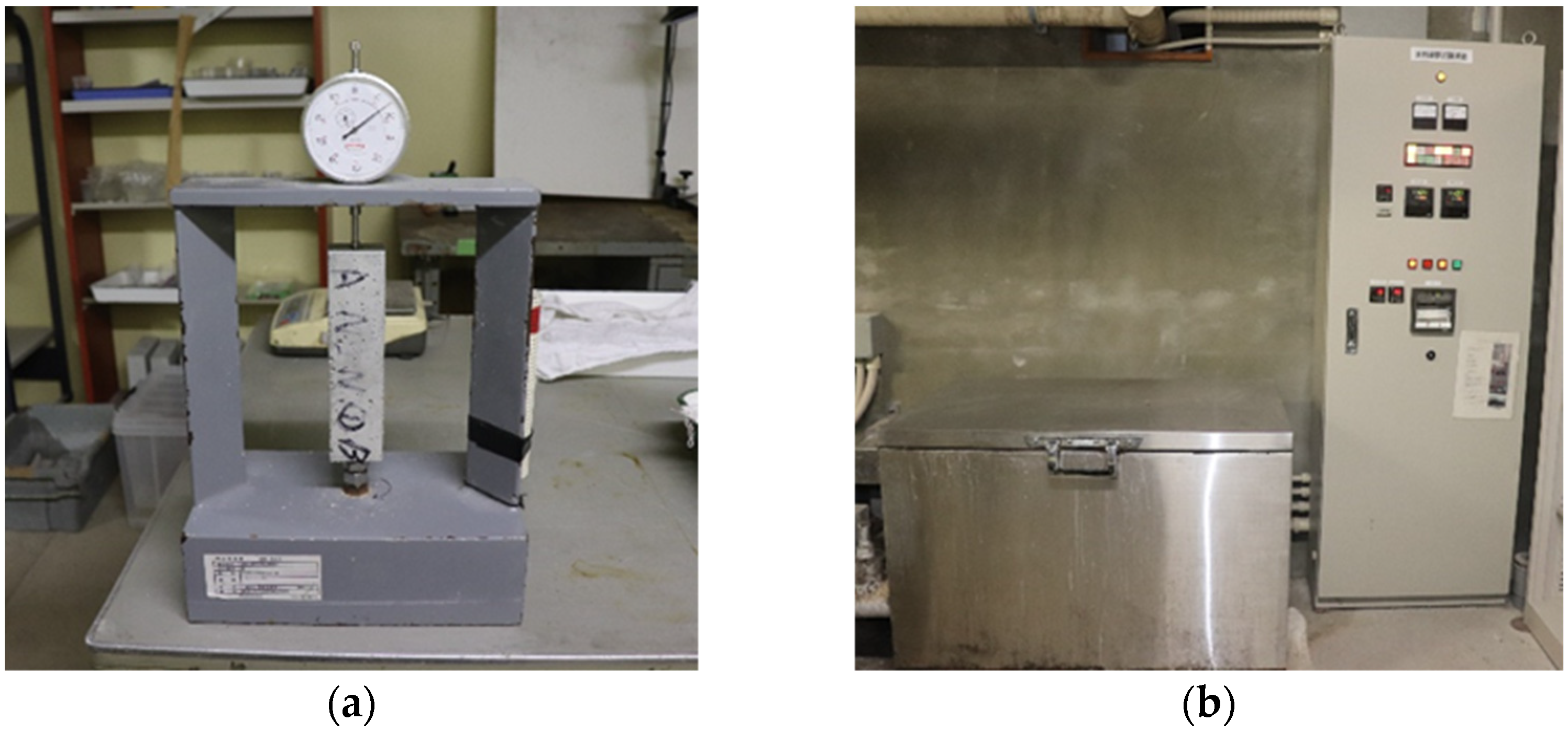



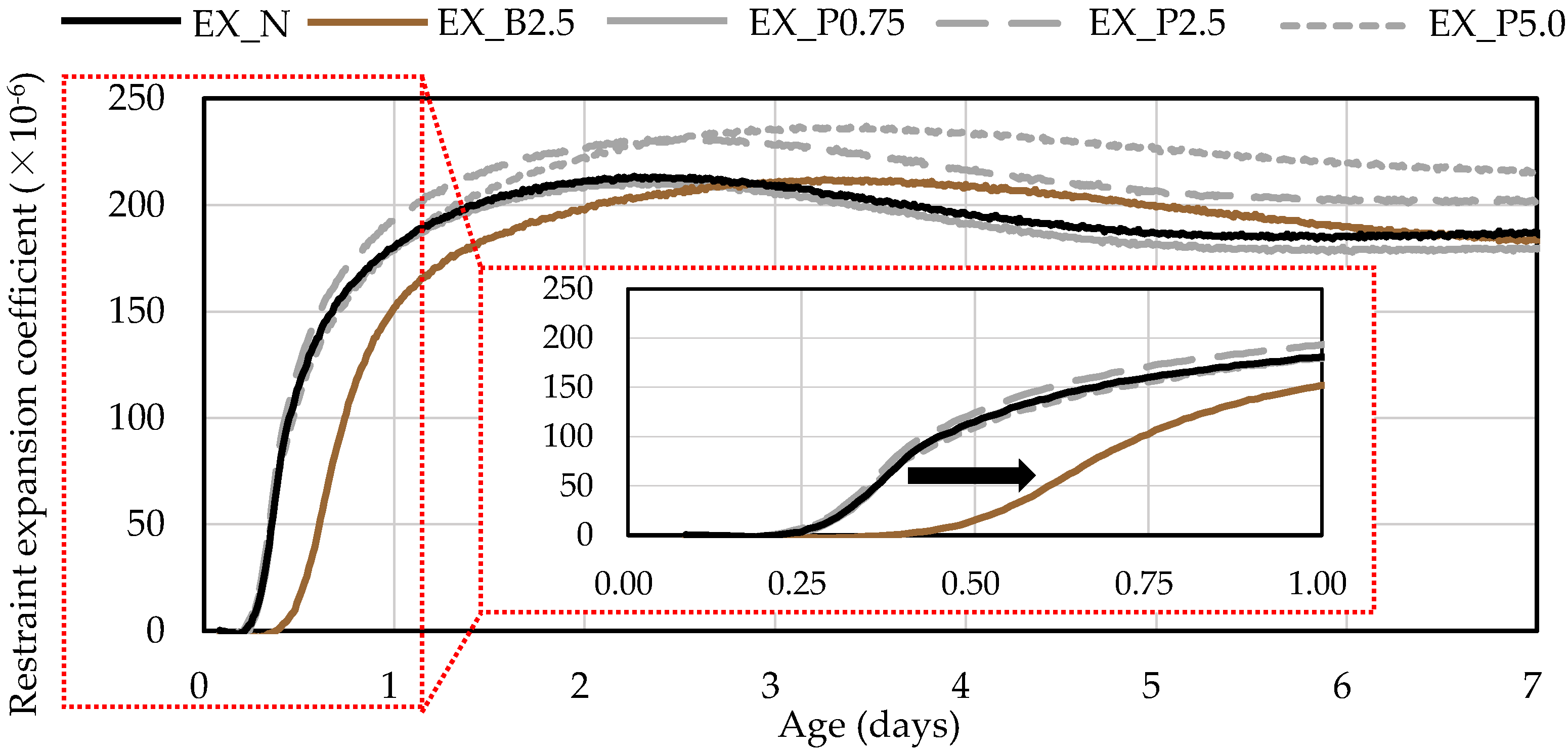
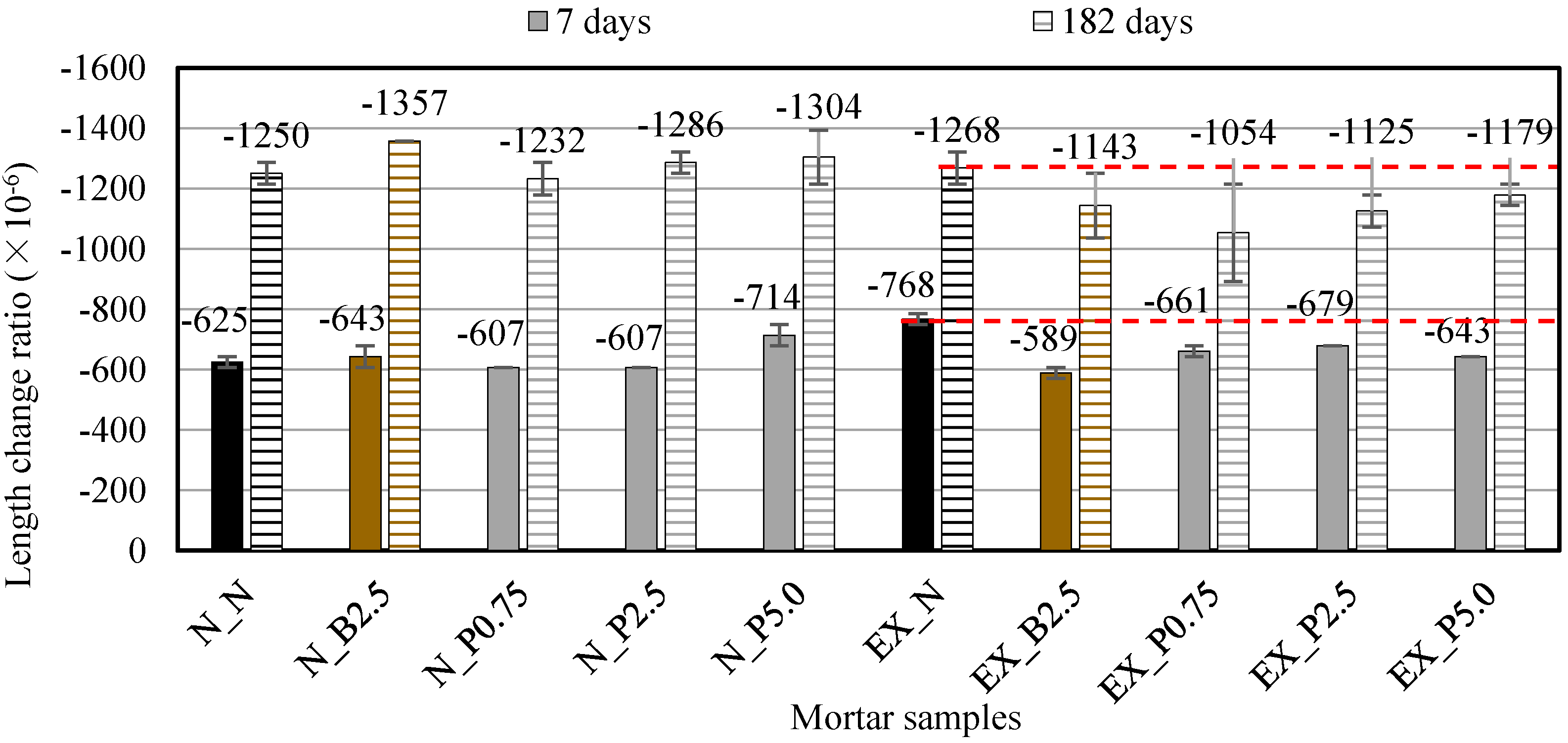
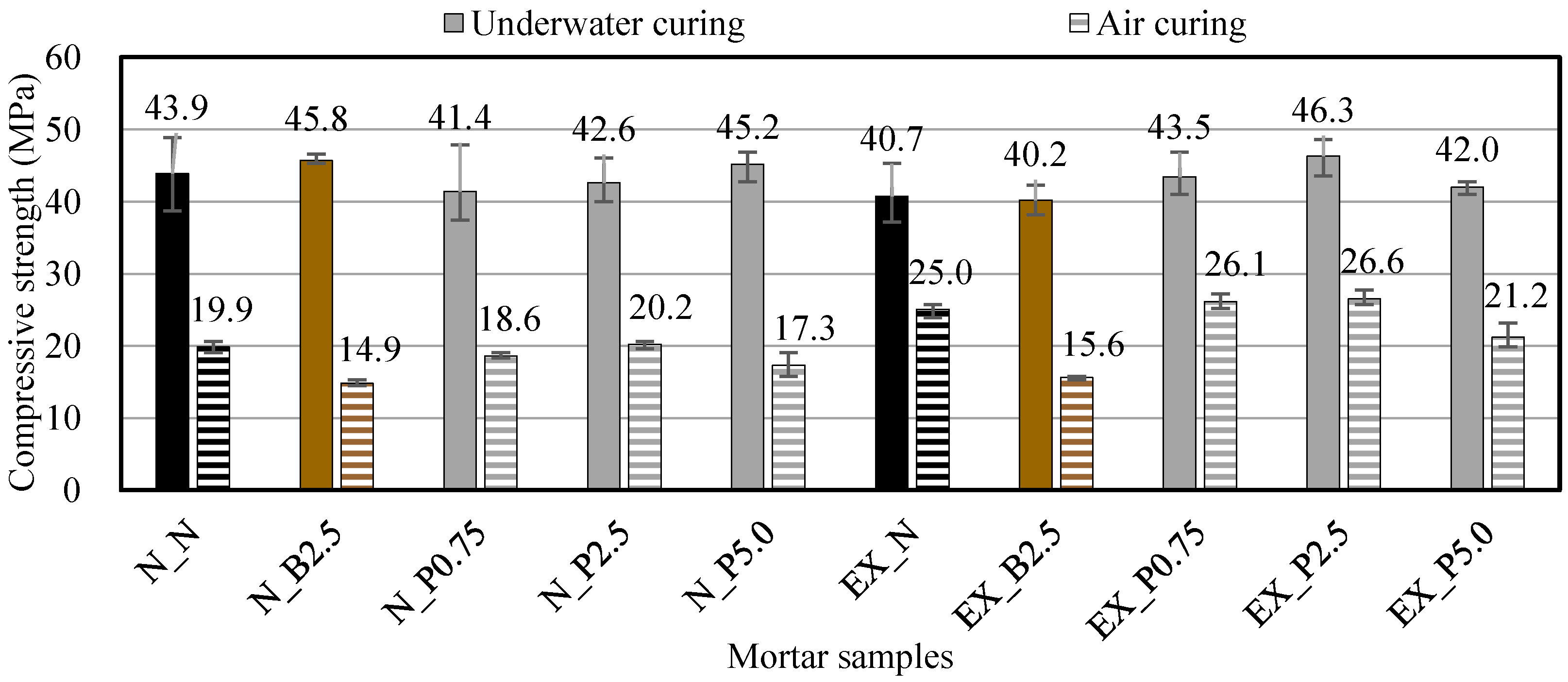

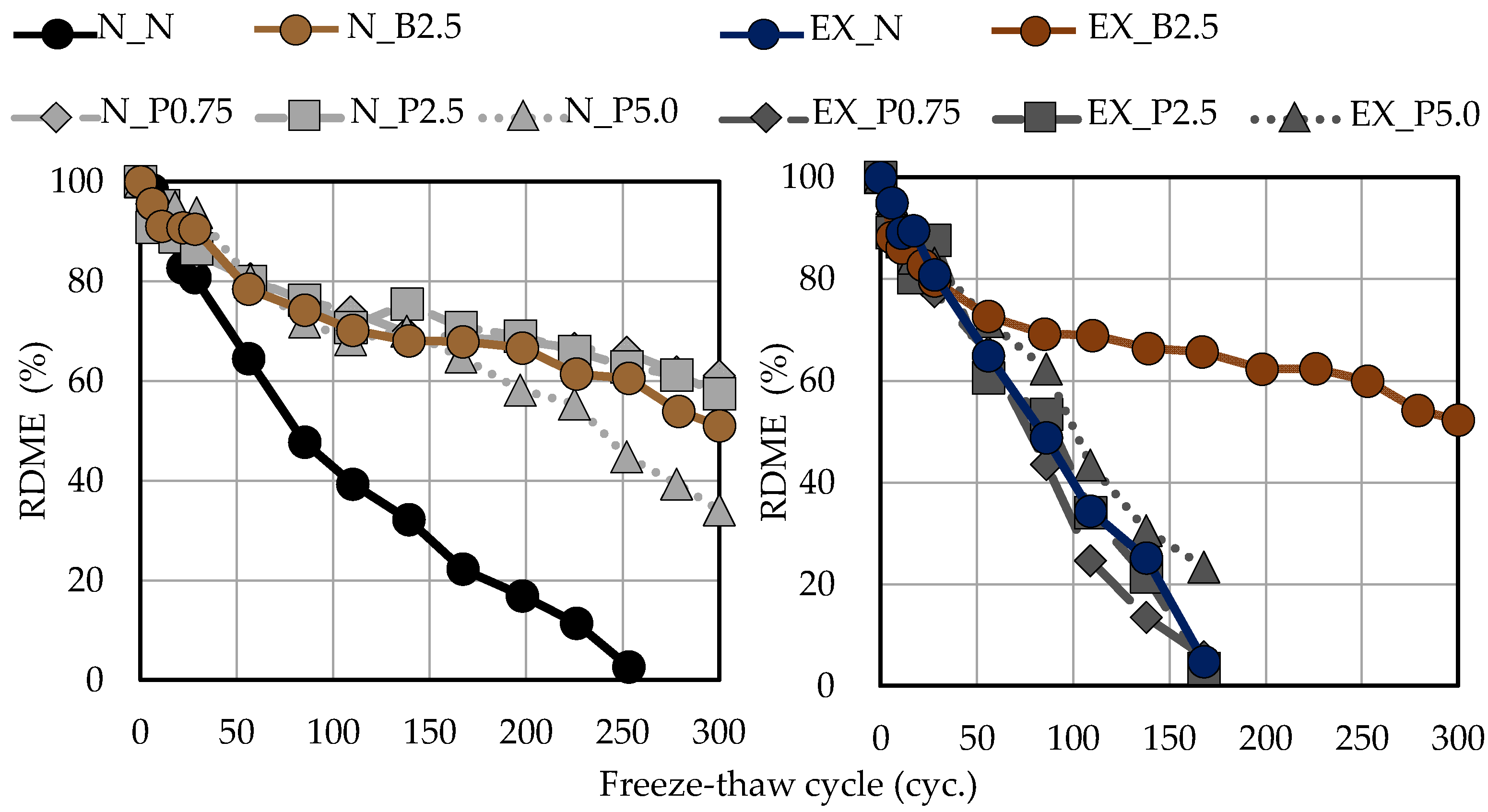
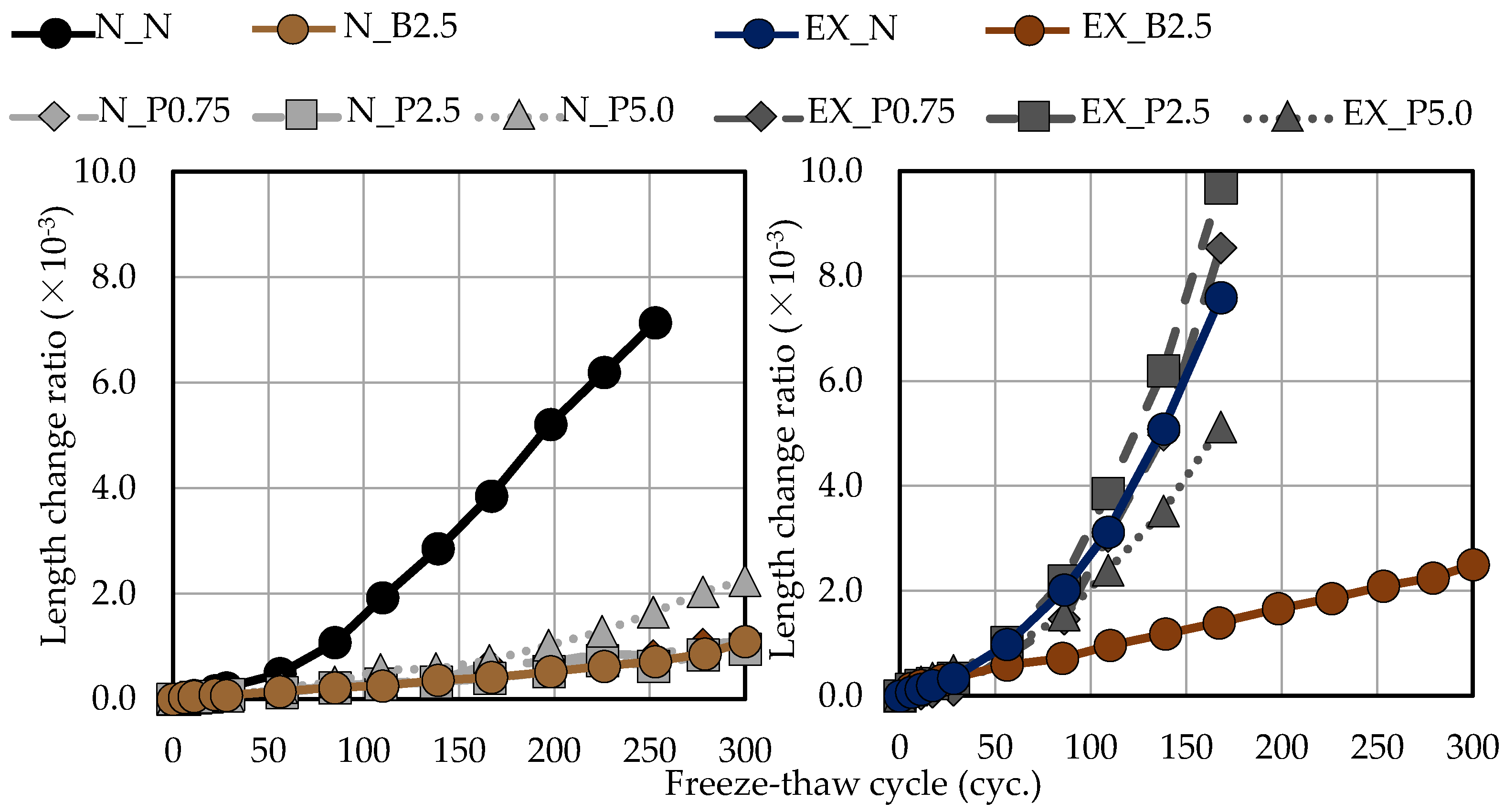
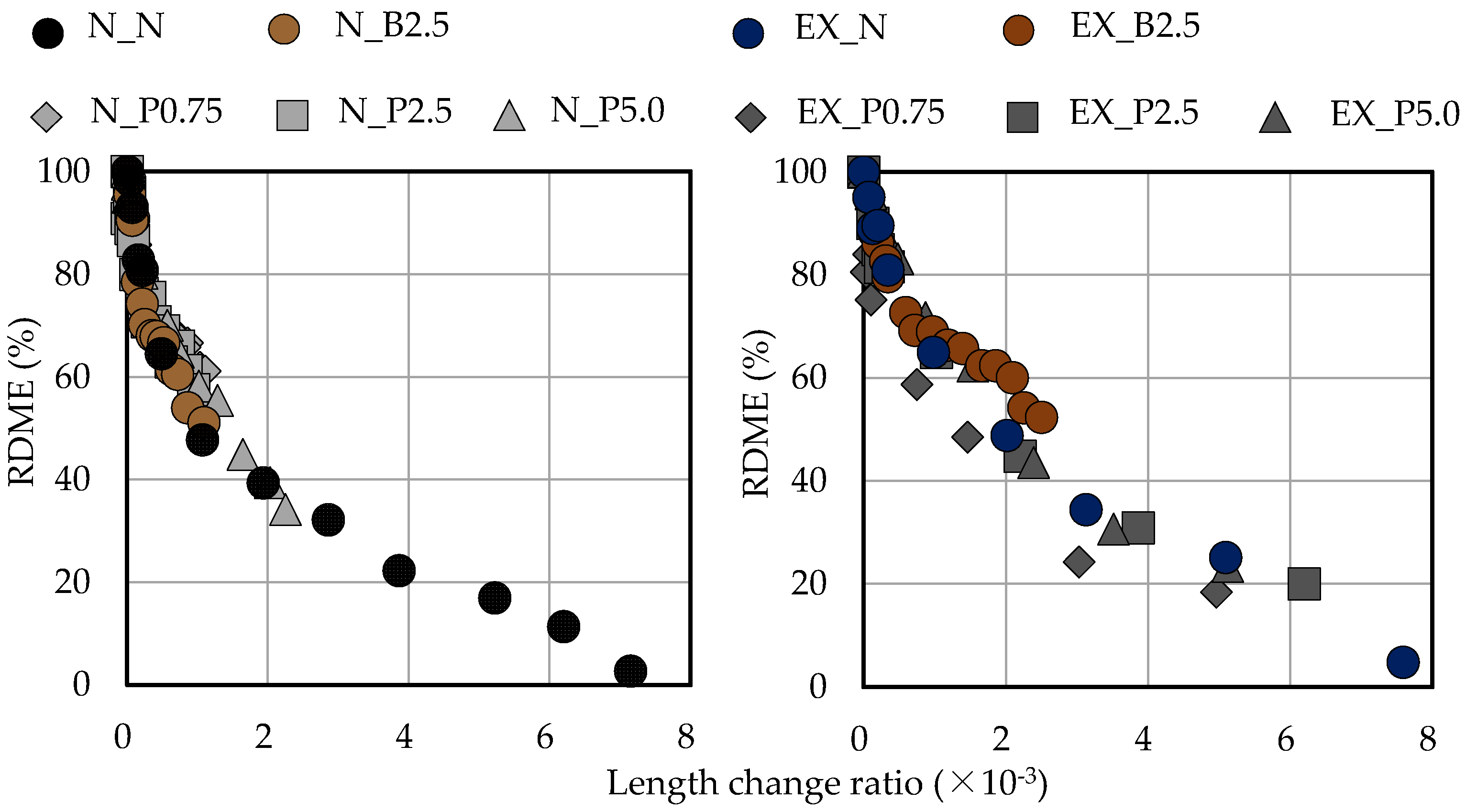
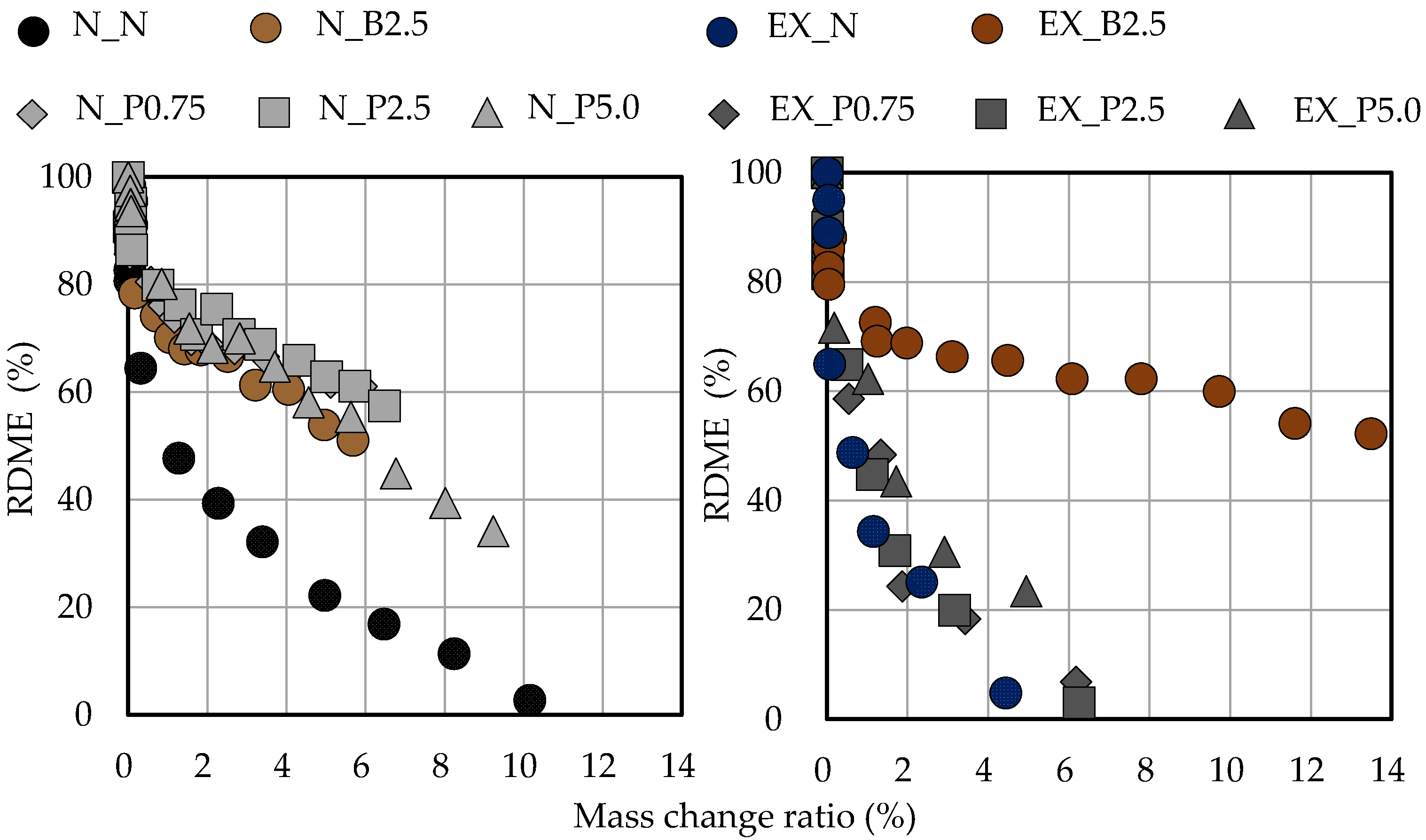
| Material | Symbol | Classification and Physical Properties |
|---|---|---|
| Cement | OPC | Ordinary Portland cement Specific gravity: 3.17 g/cm3 |
| Expansive additive | Ex | Ettringite and free CaO Specific gravity: 3.17 g/cm3 Standard usage: 20 kg/m3 |
| Sand | S | Land sand from Noboribetsu city in Japan Saturated density: 2.73 g/cm3 Oven-dry density: 2.68 g/cm3 Absorption: 1.72% |
| Nanofibrillated Bacterial Cellulose (NFBC) | Bf | CNF produced by fermentation culture solution containing bacterial cells and medium components in addition to fibers Fiber ratio: ~0.3 wt% Fiber width: 10–50 nm Fiber length: 100–500 µm |
| Pf | Purified product from Bf with bacterial cells and medium components removed Fiber ratio: ~1.0 wt% Fiber width: 10–50 nm Fiber length: 100–500 µm |
| Symbol | w/b | b (%) | NFBC | Bf or Pf Ratio b × wt (%) | Fiber Ratio in Bf or Pf b × wt (%) | |
|---|---|---|---|---|---|---|
| OPC | Ex | |||||
| N_N | 0.5 | 100 | 0 | - | 0 | 0 |
| N_B2.5 | Bf | 2.5 | 0.0075 | |||
| N_P0.75 | Pf | 0.75 | ||||
| N_P2.5 | 2.5 | 0.025 | ||||
| N_P5.0 | 5.0 | 0.05 | ||||
| EX_N | 95 | 5 | - | 0 | 0 | |
| EX_B2.5 | Bf | 2.5 | 0.0075 | |||
| EX_P0.75 | Pf | 0.75 | ||||
| EX_P2.5 | 2.5 | 0.025 | ||||
| EX_P5.0 | 5.0 | 0.05 | ||||
Publisher’s Note: MDPI stays neutral with regard to jurisdictional claims in published maps and institutional affiliations. |
© 2022 by the authors. Licensee MDPI, Basel, Switzerland. This article is an open access article distributed under the terms and conditions of the Creative Commons Attribution (CC BY) license (https://creativecommons.org/licenses/by/4.0/).
Share and Cite
Kuroiwa, E.; Quy, N.X.; Hama, Y. Influence of Nanofibrillated Bacterial Cellulose on the Properties of Ordinary and Expansive Mortars. Materials 2022, 15, 2094. https://doi.org/10.3390/ma15062094
Kuroiwa E, Quy NX, Hama Y. Influence of Nanofibrillated Bacterial Cellulose on the Properties of Ordinary and Expansive Mortars. Materials. 2022; 15(6):2094. https://doi.org/10.3390/ma15062094
Chicago/Turabian StyleKuroiwa, Emika, Nguyen Xuan Quy, and Yukio Hama. 2022. "Influence of Nanofibrillated Bacterial Cellulose on the Properties of Ordinary and Expansive Mortars" Materials 15, no. 6: 2094. https://doi.org/10.3390/ma15062094






